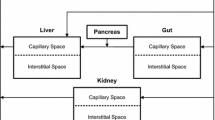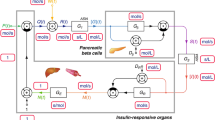Abstract
Monitoring the concentration of plasma glucose is very important to diagnose individuals with diabetes early so that the treatment of diabetes can be done early as well. The earlier diagnosis of the disease allows for better control. In general, the diagnostic determination of subjects with prediabetes or diabetes is based on the criteria of the basal threshold of measured plasma glucose statically. However, using the development of alternative diagnostic methods, the dynamic model of glucose-insulin homeostasis has become an alternative model to be used as a diagnostic model. In this study, the diagnostic model should be modified by adding the function of oral glucose absorption to the change rate of plasma glucose concentration. The modified model will adapt to the subject's diagnostic determination based on the oral glucose tolerance test (OGTT), and then the estimation of the diagnostic parameters of the model that fits the OGTT experimental data can be obtained using a modified gravitational search algorithm (GSA). The modified GSA was used to estimate the model parameters to diagnose subjects with characteristics of subjects with normal glucose tolerance (NGT), impaired glucose tolerance (IGT) or prediabetes, and type 2 diabetes mellitus (T2DM). The suitability of the simulation results and the OGTT experimental data is shown by the suitability of the correlation curve results which are assessed based on the coefficient of determination (R2). If the value of R2 is above 0.90, it means that the simulation results are said to have a good match with the experimental data. Two parameters that are commonly used as a diagnostic determination are glucose effectiveness which indicates the ability to decrease plasma glucose concentration by itself and insulin sensitivity which measures the effect of interstitial plasma insulin response when plasma glucose concentration increases. In addition, metabolic disorders caused by insulin resistance in diabetes will also be characterized by an increase in plasma glucose. Therefore, the modified model will also be used to diagnose insulin resistance based on OGTT. This diagnostic study shows good compatibility because it is evident that the parameter results obtained from the modified model are within the criteria range of subjects with NGT, IGT, and T2DM based on the literature.



Similar content being viewed by others
References
American Diabetes Association: Introduction: standards of medical care in diabetes-2018. Diabetes Care 41(Suppl. 1), S1–S159 (2018)
World Health Organisation.: Definition and diagnosis of diabetes mellitus and intermediate hyperglycaemia. (2006) http://www.who.int/diabetes/publications (accessed on 11.11.10).
Chamberlain, J.J.; Rhinehart, A.S.; Shaefer, C.F., Jr.; Neuman, A.: Diagnosis and management of diabetes: synopsis of the 2016 American diabetes association standards of medical care in diabetes. Ann. Int. Med. 164(8), 542–552 (2016)
Boston, R.C.; Stefanovski, D.; Moate, P.J.; Sumner, A.E.; Watanabe, R.M.; Bergman, R.N.: MINMOD millennium: a computer program to calculate glucose effectiveness and insulin sensitivity from the frequently sampled intravenous glucose tolerance test. Diab. Technol. Ther. 5(6), 1003–1015 (2003)
Theodorakis, M.J.; Katsiki, N.; Arampatzi, K.; Chrousos, G.P.: Modelling the oral glucose tolerance test in normal and impaired glucose tolerant states: a population approach. Curr. Med. Res. Opin. 33(2), 305–313 (2017)
Yalow, R.; Berson, S.: Immunoassay of endogenous plasma insulin in man. J. Clin. Investig. 39, 1157–1175 (1960)
Bergman, R.N.; Ider, Y.Z.; Bowden, C.R.; Cobelli, C.: Quantitative estimation of insulin sensitivity. Am. J. Physiol. 236(6), E667-677 (1979)
Wang, X.; Zhao, X.; Zhou, R.; Gu, Y.; Zhu, X.; Tang, Z.; Yuan, X.; Chen, W.; Zhang, R.; Qian, C.; Cui, S.: Delay in glucose peak time during the oral glucose tolerance test as an indicator of insulin resistance and insulin secretion in type 2 diabetes patients. J. Diab. Investig. 9(6), 1288–1295 (2018)
Dalla Man, C.; Caumo, A.; Cobelli, C.: The oral glucose minimal model: estimation of insulin sensitivity from a meal test. IEEE Trans. Biomed. Eng. 49(5), 419–429 (2002)
De Gaetano, A.; Gaz, C.; Panunzi, S.: Consistency of compact and extended models of glucose-insulin homeostasis: the role of variable pancreatic reserve. PLOS ONE 14(2), e0211331 (2019)
McAuley, K.A.; Williams, S.M.; Mann, J.I.; Walker, R.J.; Lewis-Barned, N.J.; Temple, L.A.; Duncan, A.W.: Diagnosing insulin resistance in the general population. Diab. Care 24(3), 460–464 (2001)
Matsuda, M.: Measuring and estimating insulin resistance in clinical and research settings. Nutr. Metab. Cardiovasc. Dis. 20, 79–86 (2010)
Bonadonna, R.C.; Boselli, L.; Dei Cas, A.; Trombetta, M.: Methods to assess in vivo insulin sensitivity and insulin secretion. In: Bonora, E.; DeFronzo, R. (Eds.) Diabetes Epidemiology, Genetics, Pathogenesis, Diagnosis, Prevention, and Treatment Endocrinology. Springer, Cham (2018)
Pearson, T.; Wattis, J.A.D.; King, J.R.; MacDonald, I.A.; Mazzatti, D.J.: The effects of insulin resistance on individual tissues: an application of a mathematical model of metabolism in humans. Bull. Math. Biol. 78, 1189–1217 (2016)
Eberle, C.; Palinski, W.; Ament, C.: A novel mathematical model detecting early individual changes of insulin resistance. Diab. Technol. Ther. 15(10), 870–880 (2013)
Shankar, S.S.; Shankar, R.R.; Railkar, R.A.; Beals, C.R.; Steinberg, H.O.; Kelley, D.E.: Early clinical detection of pharmacologic response in insulin action in a nondiabetic insulin-resistant population. Curr. Ther. Res. 77, 83–89 (2015)
Ormazabal, V.; Nair, S.; Elfeky, O.; Aguayo, C.; Salomon, C.; Zuñiga, F.A.: Association between insulin resistance and the development of cardiovascular disease. Cardiovasc. Diabetol. 17(122), 1–14 (2018)
Bartoli, E.; Fra, G.P.; Schianca, G.P.C.: The oral glucose tolerance test (OGTT) revisited. Eur. J. Intern. Med. 22, 8–12 (2011)
Rashedi, E.; Nezamabadi-pour, H.; Saeid Saryazdi, G.S.A.: A gravitational search algorithm. Inf. Sci. 179, 2232–2248 (2009)
Li, C.; Zhou, J.: Parameters identification of hydraulic turbine governing system using improved gravitational search algorithm. Energy Convers. Manag. 52, 374–381 (2011)
Li, C.; Zhou, J.; Xiao, J.; Xiao, H.: Parameters identification of chaotic system by chaotic gravitational search algorithm. Chaos, Solitons Fractals 45, 539–547 (2012)
Rashedi, E.; Nezamabadi-pour, H.; Saryazdi, S.: BGSA: binary gravitational search algorithm. Nat. Comput. 9, 727–745 (2010)
Siddique, N.; Adeli, H.: Gravitational search algorithm and its variants. Int. J. Pattern Recogn. Artif. Intell. 30(8), 1639001 (2016)
Rashedi, E.; Rashedi, E.; Nezamabadi-pour, H.: A comprehensive survey on gravitational search algorithm. Swarm Evol. Comput. 41, 141–158 (2018)
Zandevakili, H.; Rashedi, E.; Mahani, A.: Gravitational search algorithm with both attractive and repulsive forces. Soft. Comput. 23, 783–825 (2019)
Mirjalili S., Hashim, S.Z.M.: A new hybrid PSOGSA algorithm for function optimization. In: 2010 International Conference on Computer and Information Application, Tianjin (2010) pp. 374–377.
García-Ródenas, R.; Linares, L.J.; López-Gómez, J.A.: A Memetic Chaotic Gravitational Search Algorithm for unconstrained global optimization problems. Appl. Soft Comput. J. 79, 14–29 (2019)
Khajooei F., Rashedi, E.: A new version of Gravitational Search Algorithm with negative mass. In: 2016 1st Conference on Swarm Intelligence and Evolutionary Computation (CSIEC), Bam (2016) 1–5.
Caumo, A.; Bergman, R.N.; Cobelli, C.: Insulin sensitivity from meal tolerance tests in normal subjects: a minimal model index. J. Clin. Endocrinol. Metab. 85(11), 4396–4402 (2000)
Tolks, C., Ament, C.: Identification of parameters of the glucose-insulin homeostasis under everyday live conditions. In: 2017 IEEE EMBS International Conference on Biomedical & Health Informatics (BHI), Orlando, FL (2017) pp. 81–84.
Kartono, A.; Pratiwi, G.; Setiawan, A.A.; Wahyudi, S.T.; Sumaryada, T.: Optimization of insulin sensitivity and glucose effectiveness index from an oral glucose tolerance test using the modified oral minimal model and gravitational search algorithm. Appl. Math. Sci. 11(9), 433–443 (2017)
Eberle, C.; Ament, C.: The Unscented Kalman Filter estimates the plasma insulin from glucose measurement. BioSystems 103, 67–72 (2011)
Eberle, C.; Ament, C.: Real-time state estimation and long-term model adaptation: a two-sided approach toward personalized diagnosis of glucose and insulin levels. J. Diab. Sci. Technol. 6(5), 1148–1158 (2012)
Møller, J.B.; Dalla Man, C.; Overgaard, R.V.; Ingwersen, S.H.; Tornøe, C.W.; Pedersen, M.; Tanaka, H.; Ohsugi, M.; Ueki, K.; Lynge, J.; Vasconcelos, N.M.: Ethnic differences in insulin sensitivity, β-Cell function, and hepatic extraction between japanese and caucasians: a minimal model analysis. J. Clin. Endocrinol. Metab. 99(11), 4273–4280 (2014)
Acknowledgements
This research was supported by a grant from the Directorate of Research and Community Service, Ministry of Research, Technology and Higher Education, Indonesia, with a Contract Number: 2018/IT3.L1/PN/2021 on March 15, 2021.
Author information
Authors and Affiliations
Contributions
AK and IAM conceived and designed the simulation method; AK and IAM performed the simulations; STW, AAS and TS analyzed the simulation results and experimental data; AK, IAM, STW, AAS and TS contributed to the writing of the manuscript.
Corresponding author
Ethics declarations
Conflict of interest
The authors state that there is no conflicts of interest that could be perceived as detrimental to the impartiality of the research published.
Rights and permissions
About this article
Cite this article
Kartono, A., Mafahir, I.A., Wahyudi, S.T. et al. A New Method for Estimating Diagnostic Parameters in the Dynamics Model of Modified Glucose-Insulin Homeostasis from the Oral Glucose Tolerance Test Using a Gravitational Search Algorithm. Arab J Sci Eng 47, 989–1001 (2022). https://doi.org/10.1007/s13369-021-05945-5
Received:
Accepted:
Published:
Issue Date:
DOI: https://doi.org/10.1007/s13369-021-05945-5




